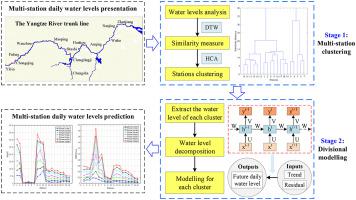Environmental Modelling & Software ( IF 4.8 ) Pub Date : 2022-08-05 , DOI: 10.1016/j.envsoft.2022.105468 Zhi Yuan , Jingxian Liu , Yi Liu , Qian Zhang , Yue Li , Zongzhi Li

|
Water level prediction is an essential task in inland water transportation and infrastructure operation. In recent years, the level of uncertainty in the water level variation has increased significantly due to the climate change. Therefore, the need to develop more robust and accurate models for multi-station daily water level prediction along the long and volatile inland rivers has greatly increased. This research proposes a two-stage modelling method to enhance the accuracy and efficiency in simultaneous prediction of daily water levels for multiple stations in inland rivers. Furthermore, taking the Yangtze River trunk line as case study, the daily water data of 19 stations are collected and utilised to verify the performance of the models. First, we divide the 19 stations along the Yangtze River trunk line into 6 clusters by dynamic time warping (DTW) and hierarchical clustering algorithm (HCA). Then, the long short-term memory (LSTM) network and seasonal autoregressive integrated moving average (SARIMA) model are tailored to construct a multi-station daily water level prediction (MSDWLP) model for each cluster. Finally, to validate the proposed method, the daily water level data of 912 consecutive days from the 19 stations are employed. The results demonstrate that the proposed approach can yield more reliable forecasts than traditional deterministic models. Insight from the models can be used to predict daily water levels to better inform decision-making about waterborne transportation, water resources management, and water emergency response.
中文翻译:

一种多站日水位预测的两阶段建模方法
水位预测是内河运输和基础设施运营中的一项重要工作。近年来,由于气候变化,水位变化的不确定性水平显着增加。因此,对于沿长而波动的内陆河流的多站每日水位预测开发更稳健和准确的模型的需求已大大增加。本研究提出了一种两阶段建模方法,以提高同时预测内陆河流多个站点的每日水位的准确性和效率。此外,以长江干线为例,收集并利用19个站点的日用水数据来验证模型的性能。第一的,我们通过动态时间规整(DTW)和层次聚类算法(HCA)将长江干线沿线的19个站点划分为6个聚类。然后,定制长短期记忆(LSTM)网络和季节性自回归综合移动平均(SARIMA)模型,为每个集群构建多站日水位预测(MSDWLP)模型。最后,为了验证所提出的方法,使用来自 19 个站点的连续 912 天的每日水位数据。结果表明,与传统的确定性模型相比,所提出的方法可以产生更可靠的预测。模型的洞察力可用于预测每日水位,以更好地为有关水上运输、水资源管理和水资源应急响应的决策提供信息。











































 京公网安备 11010802027423号
京公网安备 11010802027423号